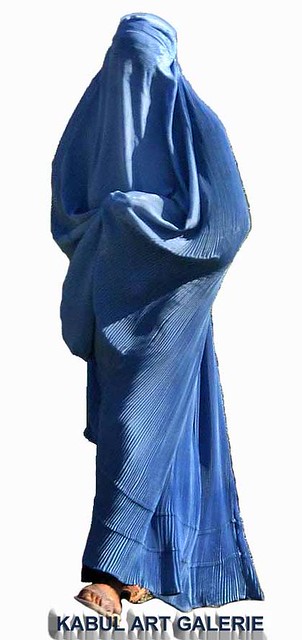The World from Under my Mom’s Burqa
Having seen my mom wear a burqa to school and outside home for several years, I wanted to see how it feels to wear one. I took my mom’s ‘mobile jail’ and put myself in it for a minute. I felt so bored and depressed. Everything seemed blurry and I had no peripheral vision for that one minute. I felt dizzy when I took it off. Then I gave my mom a very long hug to show my sympathy.
The world from under my mom’s burqa:

Burqa and Its History
Worn by women in some Islamic societies burqa is an enveloping garment that has a small eye grid through which women can see. It covers them from head to toes. They wear it when they go out of home.
Clothing that is recommended to Muslim women in Islam is called
hijab. Hijab covers a woman’s arms, legs, chest and hair. By covering her “beauties” (as referred to in Islam) a woman maintains her modesty. These parts of a woman’s body should be viewed by her husband only. Burqa is a stricter version of the clothing that Islam recommends for women.

Photo credit: Chesi-Foto CC
Women in Pakistan have been wearing burqa for over 400 years. “In Pakistan, women are told that men are wolves and women are sheep.” Quoted from this article. A similar perception exists in Afghanistan. Since men and women are taught this from a very young age, most men do act like wolves and women as sheep.

Photo by Lauras Eye
Burqa in Afghanistan
Burqa has been part of the Afghan culture for 200 years. However, it’s been more common and strict in certain times. Under the Taliban regime, women in Afghanistan were forced to wear a burqa. A lot of families could not afford it as it was expensive. More time, effort and material is used to make a burqa. One burqa costs $10-$14 in Afghanistan. Some women wore a chador, which is made out of a large rectangle of cloth. Wrapped around most of a woman’s body, a Chador is pulled across face with a little opening for eyes.
The Taliban did not restrict women’s clothing only but they also required all men to wear a white hat, keep their hair short and leave their beards long.
After the Taliban’s regime, most women in large cities of Afghanistan gradually switched to Chador. Chador is a bit more comfortable than burqa. More than ten years after the fall of Taliban, a lot of women still wear a burqa. In spite of all these layers that they wear, a male member of the family escorts women when they go out of their homes. It’s a lot more common in rural areas where most of the population is uneducated. There, women look at their husbands as their owners. Some men won’t allow their women to have a photo on their voter’s ID card. A male member of their family brings their card home for them for a fingerprint.

How beautiful in this?
In Afghanistan, there is a sense that the extremists are watching everything you do. In many parts of the country, there is a constant fear that the Taliban would retaliate against women who do not wear“modest clothes”. The Taliban poured acid at a group of girls’ faces as they were on their way to school in Kandahar. These students were wearing descent clothes but they were not burqas.
Besides the Taliban, some women feel uncomfortable not wearing it because the rest of the community would judge them. For example, my mom, though she is OK with my other sisters not wearing a burqa, she wears it herself.
Why a burqa cannot protect women or even prove modesty?
Do all these layers and escorts really protect women from other men or does that isolate and degrade them?
Toes and ankles are the only parts of a woman under a burqa that you can see. Even then some men would still try hauling insults at them as they walk by.
My uncle in Pakistan was trying to flirt with a girl under a burqa he described as sexy. She went ahead and acted suggestively before him. He complimented on her nail polish. After an hour of flirting, the “sexy girl” inched closer to him and gently tossed back her burqa over her head.
My uncle blushed and hid his face with his hands when he saw his forty something years old cousin standing in front of her. He was extremely embarrassed. Then my aunt went on sharing the tale with the rest of the family and relatives.
A burqa neither protects women from other men, it only isolates and degrades them, nor is it a proof of modesty. Not to say that it prevents them from enjoying a nice breeze.

